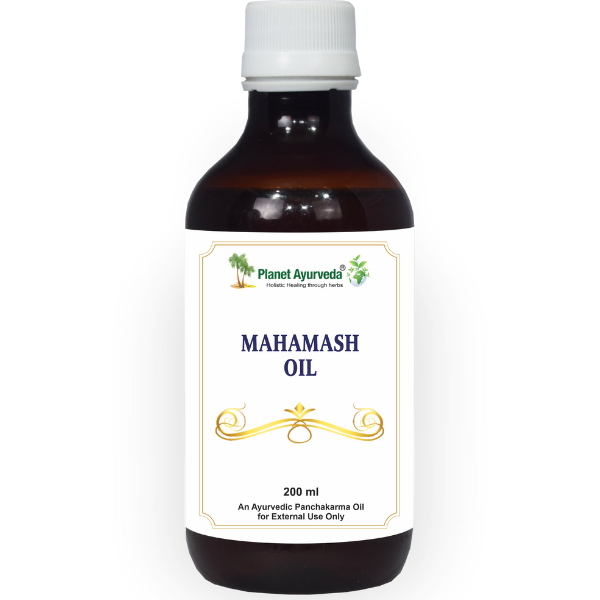Mahamash Oil – Key Ingredients, Their Benefits, Indications & Panchakarma Uses
Introduction
Mahamash Oil, a classical Ayurvedic medicated oil from Planet Ayurveda, is renowned for its therapeutic benefits in neurological, musculoskeletal, and Vata-related disorders. Its main ingredient is black gram, blended along with herbs, milk, and sesame oil, which provides nourishing and strengthening properties. Traditionally used in Abhyanga (massage), Pizhichil, and Basti therapies, Mahamash Oil helps ease Vata-related disorders like paralysis, sciatica, back pain, and muscular weakness while imparting deep nourishment and vitality to the body.
Key Ingredients With Benefits
1. Ashwagandha (Withania somnifera)
Ashwagandha is one of the key ingredients in Mahamasha Oil, which plays a major role in its rejuvenating and neuroprotective effects. It possesses withanolides, sitoindosides, and alkaloids, and these phytoactive compounds provide neuroprotective, anti-inflammatory, antioxidant, and adaptogenic effects.
2. Karchur (Curcuma Zedoaria)
Karchura (Curcuma zedoaria) contains curcuminoids, essential oils (curzerenone, germacrone, curdione), and flavonoids that exhibit strong anti-inflammatory, antioxidant, and analgesic effects. These bioactive compounds help reduce nerve inflammation, improve blood circulation to muscles, and support nerve repair and recovery.
3. Devdaru (Cedrus deodara)
Devadaru is an important ingredient in the above-mentioned oil; it contains sesquiterpenes, flavonoids, and essential oils that possess anti-inflammatory, analgesic, anti-arthritic, and neuroprotective properties. These active compounds help to reduce muscle spasms and improve nerve conduction, which assists recovery in neuromuscular disorders.
4. Pluchea Indica
Pluchea indica contains flavonoids, tannins, triterpenoids, alkaloids, and sterols that provide anti-inflammatory and antioxidant benefits. Bioactive compounds in this herb help to reduce nerve and joint inflammation, relieve muscular and arthritic pain, and protect tissues from oxidative stress. It helps in neuromuscular health and arthritic conditions.
5. Paederia Foetida
Paederia foetida possesses anti-inflammatory, antioxidant, anti-rheumatic, and nerve-stimulating properties that help relieve pain, reduce inflammation, and support nerve and muscle function in neuromuscular diseases. It has iridoid glycosides, flavonoids, alkaloids, and essential oils that contribute to these qualities.
6. Vidari (Pueraria Tuberosa)
Pueraria tuberosa in Mahamasha Oil helps in reducing neuromuscular inflammation, promoting nerve repair, and improving muscle function in neuromuscular diseases by the action of isoflavonoids and with flavonoids like quercetin and isoorientin.
7. Ipomoea Batatas
It contains polyphenols, flavonoids, anthocyanins, vitamins, and minerals that help to reduce oxidative stress in nerves and muscles, improve neuromuscular function, and support recovery in neuromuscular disorders like paralysis, neuralgia, and muscle weakness.
8. Punarnava (Boerhavia Diffusa)
Punarnava contains compounds with potent anti-inflammatory, diuretic, and antioxidant properties that help reduce joint pain, swelling, and muscle stiffness. It supports nerve and muscle health by balancing Vata and Kapha dosha, promoting joint comfort, and aiding in tissue detoxification and repair, which is beneficial in neuromuscular diseases.
9. Shatavari (Asparagus Racemosus)
Shatavari contains beneficial compounds such as saponins like Shatavarins, Quercetin, rutin, and antioxidants like racemofuran that help strengthen nerves, improve muscle tone, and reduce inflammation.
10. Nimbuka (Citrus Medica Limonum)
Nimbuka is rich in vitamin C, flavonoids, limonene, citric acid, and essential oils that provide antioxidant and rejuvenating effects. These compounds help reduce oxidative stress, improve nerve and muscle metabolism, and support recovery in neuromuscular disorders.
11. Jeeraka (Cuminum Cyminum)
Jeeraka (Cuminum cyminum) contains bioactive compounds such as cuminaldehyde, terpenes, and flavonoids, which have anti-inflammatory, analgesic properties. These compounds help reduce inflammation and oxidative stress in joints and muscles, and alleviate pain and stiffness.
12. Hing (Ferula Asafoetida)
It contains active compounds like ferulic acid, umbelliferone, asaresinotannols, and sulfur compounds, and it possesses antispasmodic, analgesic, and nervine stimulant actions. These bioactive constituents help reduce pain, inhibit inflammation, and relax muscle spasms. They act on balancing the Vata dosha.
13. Mishreya (Foeniculum Vulgare)
It acts as an antioxidant, anti-inflammatory, antispasmodic, and carminative, helping to reduce joint inflammation, muscle stiffness, and spasms. It helps to reduce Vata dosha.
14. Gokshura (Tribulus Terrestris)
Gokshura (Tribulus terrestris) contains active compounds saponins (protodioscin), alkaloids, flavonoids, and tannins. It possesses muscle relaxant and nervous tonic properties, which in turn help to reduce joint pain, swelling, and stiffness, while strengthening nerves and muscles.
15. Masha (Vigna Mungo)
Masha (Vigna mungo), the chief ingredient of Mahamasha Oil, contains proteins, essential amino acids, flavonoids, tannins, and minerals like calcium, potassium, magnesium, and iron. These have nourishing, strengthening, and anti-inflammatory effects. It helps rejuvenate nerves, improve muscle tone, and support bone health.
Benefits Of Mahamash Oil
- Improves nerve function and mobility
- Aids in recovery post-injury or stroke
- Reduces chronic joint and muscle pain and stiffness
- Helps relieve symptoms of neuropathy and paralysis
- Enhances overall strength, flexibility, and circulation
Therapeutic Indications Of Mahamash Oil
- Hanustambha (Lockjaw)
- Katistambha (restricted movement of the lumbo-sacral region)
- Pangutva (Paraplegia)
- Vatashleshmaroga (diseases due to Vata and Kapha Dosha)
- Ardita (Facial palsy)
- Prishthastambha (stiffness of the back)
- Shiro-griva-stambha (stiffness of head and neck)
- Adhimantha (Ophthalmia, excruciating pain develops headache)
- Khanja (Monoplegia)
- Arthritis
- Osteoarthritis
- Rheumatism
- Palsy
- Paralysis
- Headache
- Tinnitus
- Joint pains
- Cervical spondylosis
- Muscular dystrophy
- Migraine
Panchakarma Use
Mahamash Oil is extensively used in Ayurvedic Panchakarma therapy primarily for its efficacy in relieving joint pain, muscle stiffness, paralysis, and many nerve disorders.
Abhyanga (Therapeutic Massage)
Applied externally to the whole body or specific areas to reduce stiffness, improve muscle tone, and enhance circulation, thereby helping in neuromuscular disorders, arthritis, and chronic joint pain by lubricating joints and relaxing muscles.
Local Snehana (Targeted Oil Application)
As Kati Basti (on the lower back), Janu Basti (on the knees), or Greeva Basti (on the neck), Mahamash Oil is applied to affected joints, muscles, or paralyzed limbs to reduce inflammation and pain and aid recovery in paralysis, sciatica, and muscular weakness.
Shirobasti (Retaining Oil On Head)
Shirobasti with Mahamasha Oil is particularly recommended for paralysis, neuralgia, chronic headaches, and other neuromuscular disorders.
Basti (Medicated Enema)
Used in combination with Basti (medicated enemas) and other Panchakarma procedures to enhance neuromuscular strength, vitality, and overall well-being.
Use Of Mahamash Oil
- With Kshirabala Taila: It helps to improve neuromuscular tone, paralysis management, and insomnia.
- With Dhanwantharam Taila: Provides superior relief in musculoskeletal stiffness, rheumatic pain, and postnatal care.
- With Mahanarayana Taila: Enhances recovery in neurological weakness, arthritis, and degenerative joint disorders.
- With Bala Taila: Increases muscle strength, reduces fatigue, and supports Vata disorders with muscle wasting.
- With Sahacharadi Taila: Effective in sciatica, lower limb weakness, and nerve-related pain.
To buy Mahamash Oil, please visit store.planetayurveda.com/products/mahamash-oil
Conclusion
Mahamash Oil is a classical Ayurvedic formulation from Planet Ayurveda known for its impressive therapeutic effects on neurological, musculoskeletal, and Vata-related disorders. Its unique composition, primarily with black gram, sesame oil, milk, and a blend of rejuvenating herbs like Ashwagandha, Karchura, and Devadaru, nourishes nerves and muscles, reduces inflammation, and improves circulation and nerve function, making it highly effective in disorders such as paralysis, neuralgia, arthritis, and muscle weakness.




